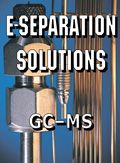Preparative and Process Chromatography
Although liquid chromatography (LC) is most commonly associated with analytical techniques that are found inside the laboratory, LC also has been used in industrial applications for separation of a wide range of products for decades.
Although liquid chromatography (LC) is most commonly associated with analytical techniques that are found inside the laboratory, LC also has been used in industrial applications for separation of a wide range of products for decades. The technique recently has been applied to requirements in the pharmaceutical and biotechnology industries, both inside the laboratory and in industrial settings. With global sales of over $1.7 billion, the market for preparative LC has encountered a stellar growth over the past few years.

Separation Instrumentation Demand
The steady growth of pharmaceutical and biotechnology research is continuing to drive strong demand for preparative chromatography, which has become a very commonplace laboratory preparative technique for improving a wide range of analyses. With the increase of the number of drug candidates reaching clinical trial phases, and full approval, non-analytical chromatography is seeing dramatic growth at the pilot and process scales.
The preparative and process chromatography market, including prep HPLC and LPLC, flash, SFC, SMB, pilot, and process-scale chromatography, is likely to benefit from the FDA initiative to modernize the regulation guidelines of pharmaceutical manufacturing. Drug makers have often been reluctant to change manufacturing processes and equipment because of regulatory hurdles. Among other measures, an effort is being made to accommodate process changes that would support continuous process improvement and encouraging the use of modern tools.
According to SDi's estimates, the 2007 market for HPLC chiral columns is about $30â50 million. The pharmaceutical industry is responsible for the majority of the market and is expected to drive future growth. Applications in agriculture and chemical markets also fuel demand.
The foregoing data was extracted from SDi's upcoming Market Analysis and Perspectives report titled Purification Applications for Process and Preparative Liquid Chromatography. For more information, contact Glenn Cudiamat, VP of Research Services, Strategic Directions International, Inc., 6242 Westchester Parkway, Suite 100, Los Angeles, CA 90045, tel. (310) 641-4982, fax (310) 641-8851, e-mail cudiamat@strategic-directions.com.
Regulatory Deadlines and Supply Chain Challenges Take Center Stage in Nitrosamine Discussion
April 10th 2025During an LCGC International peer exchange, Aloka Srinivasan, Mayank Bhanti, and Amber Burch discussed the regulatory deadlines and supply chain challenges that come with nitrosamine analysis.
Polysorbate Quantification and Degradation Analysis via LC and Charged Aerosol Detection
April 9th 2025Scientists from ThermoFisher Scientific published a review article in the Journal of Chromatography A that provided an overview of HPLC analysis using charged aerosol detection can help with polysorbate quantification.











